



Alternative Genetics to Improve Egg Layer Efficiency
G.B. Parkinson of Livorno Consulting and W. Stanhope of Stanhope Poultry Breeders reported on the development of a bantam gene pool that has commercial egg production characteristics that can be easily hybridised with elite commercial stocks, without compromising commercial performance, at the Australian Poultry Science Symposium 2011.Summary
This paper reports on the development of a bantam gene pool that has commercial egg production characteristics that can be easily hybridised with elite commercial stocks without compromising commercial performance. The usefulness of these genes has been illustrated by conducting cross breeding experiments and undertaking progressive introgression of the bantam genes into commercial lines. The bantam genes provide a mechanism to reduce metabolic body size without compromising egg mass output and hence improve overall efficiency.
To validate the use of these bantam genes, an experiment was undertaken in which a bantam White Leghorn male (Bantam Line (1) male) with commercial egg production traits was crossed with a normal sized commercial female White Leghorn (WL) line. The bantamised experimental cross was then compared to offspring of a conventional commercial White Leghorn (WL), and this study follows on from earlier experimentation between 2000-2006.
The average body weight of the bantam cross was 12.8 per cent less than the body weight of the commercial White Leghorn (1575g versus 1806g at 45 weeks of age), and egg mass output of the bantam cross was not significantly different from the commercial WL. The estimated average feed intake was 10 per cent less in the bantam cross and feed efficiency could be reduced by 9 per cent. The individual bird studies of the bantam cross identified a sub-population of birds with very small body size and high egg mass outputs, that far exceed the bantam cross average performance, and meet contemporary industry standards for egg mass output at low body weights. Overall, the recent results are much more convincing than earlier experimentation and provide the egg industry with an opportunity for a quantum efficiency leap by reducing body weight and maintenance requirements whilst holding egg mass output relatively constant.
Introduction
Genetic selection over the last 40 years has seen substantial improvements in the performance of laying hens. The combined effects of reduced body weight, lower maintenance requirements and increased egg production have seen a significant improvement in feed conversion efficiency. The rates of feed efficiency gain are likely to slow as egg production approaches the threshold of 365 eggs per annum. For further efficiency gains beyond the current genetic equilibrium, additional reductions in body weight and maintenance requirements will be required, whilst holding egg mass output relatively constant.
Considering the global projections for population growth and the dramatic requirement for additional food supply to complement this growth, strategies that maintain or increase output of dietary protein (meat) for less input of grain resources are vitally important. The bantamisation of commercial egg laying stocks offers a new biological efficiency strategy for the global egg industry (Yoshida and Saito, 1983, Stanhope and Parkinson, 1989, Parkinson and Cransberg, 2000) that will assist in ensuring global food security.
Promising results have been achieved by introgressing special bantam genes into elite commercial egg laying stocks. The pure line bantam White Leghorns owned by Stanhope Poultry Breeders have a range of mature body weights from 1000 to 1300g and these lines have been used to produce first cross bantam White Leghorns varying in female mature body weight from 1350g to 1650g. Research has been investigating the biological outcomes in three different experimental crosses designed to produce either extreme small body size, large eggs or high rates of egg production in first cross bantam lines.
The pure line Stanhope bantams described have been studied in controlled environment shedding between 2000 and 2006, and large improvements in peak production, persistency of production and egg weight have been achieved by slightly increasing 18 week old body weights from 1000 to 1100g and delaying photo-stimulation from 16 weeks to 18 weeks of age (Figure 1.). Average egg size for these pure bantam lines was recorded between 57 to 59 g and the maximum egg weight to body weight ratio has been recorded at 5.4 per cent with mature body weights of 1100-1200g live weight.
The experiment reported in this paper is part of a series of long term studies designed to evaluate the production performance characteristics and general viability in single-bird cages of a cross between a extremely small bantamised WL male (Bantam line 1) and a commercial WL female, relative to the performance of a commercial WL cross that uses the identical commercial female line.
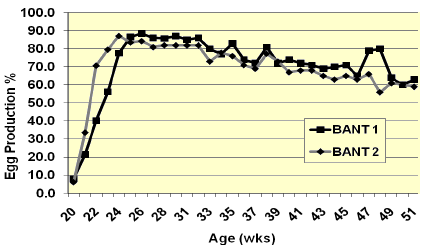
Materials and Methods
The strains used in these experiments were a commercial WL (mature female body weight 1,800g), and a cross between a bantam WL male (Bantam Line 1) (mature body weight of bantam male approximately 1,300 grams) and the commercial WL female. Some 97 bantam cross birds and 44 commercial WL were reared in cages in a controlled environment shed, fed commercial diets and were exposed to controlled day-length with a light intensity of approximately 5 to 10 lux to 14 weeks of age. At 14 weeks of age, all birds were placed into single bird cages in an environmentally controlled shed with temperatures ranging from 18-28°C with an average of 21-23°C.
All birds were fed a commercial grower ration (12.1MJ ME/kg and crude protein 160g/kg) between 9-18 weeks of age, followed by a commercial layer diet (11.61MJ ME/kg, crude protein of 18.5 per cent and 3.75 per cent calcium) for the remainder of the experimental period. Feed and water were available ad libitum and light stimulation was provided at 18 weeks of age by increasing daylength from 11 to 16 hours between 18 to 20 weeks of age. Light was constant at 16 hours per day, with a light intensity of 5-10 lux.
Birds were weighed at 16 and 45 weeks of age. Egg production was recorded daily and accumulated to provide weekly figures. Egg weight was recorded for all individual birds at 28 and 45 weeks of age, (all eggs from a particular day were weighed) while feed consumption was calculated from a sub-sample of ten individual birds from each strain between 35 to 40 weeks of age. Average feed intakes calculated between 35-40 weeks of age was used to estimate overall cumulative feed intake between 18 and 50 weeks of age (224 days). Total egg mass was estimated by multiplying the total recorded egg numbers by the estimated average egg weight between 18 and 50 weeks of age.
Results
Comparison summary of Bantam cross with Commercial WL
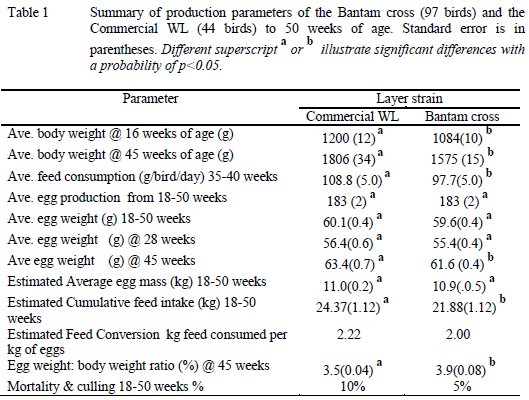
Body weight
At 16 and 45 weeks of age, the bantam cross had an average body weight of 1084 and 1575g, respectively, whilst the commercial WL was 1200 and 1806g at the same ages. The bantam cross was significantly smaller (P<0.05) than the commercial WL from 16-45 weeks (Table 1.) with 12.8 per cent lower mature body weight.
Egg Production
The bantam cross had high levels of egg production, peaking at 94 per cent at 22-23 weeks of age (Figure 2), whilst the commercial WL line peaked at 97 per cent at 25 weeks of age. Average egg production from 18 to 50 weeks of age was 81.7 per cent in the bantam cross and 81.7 per cent in the commercial WL. Total egg production to 50 weeks of age was identical for both genetic lines at 183 eggs to 50 weeks of age. The bantam cross commenced egg production earlier and there is a trend toward lower persistency of production by 45 weeks of age than the commercial WL.
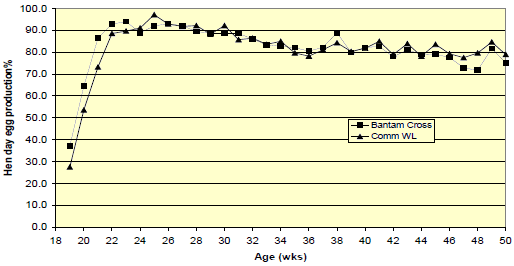
Birds housed in single bird cages.
Egg weight
The average egg weight of the commercial WL tended to be 1 to 2g greater than the bantam cross in the later period of the experiment (45 weeks), although the overall difference was not significantly different between 18 and 50 weeks of age (Table 1.). Average egg weight from week 18 to 50 was 59.6g in the bantam cross and 60.1g in the commercial WL. The egg weight to body weight ratio at 45 weeks was significantly higher in the bantam cross (3.9 per cent) than the commercial WL (3.5 per cent) (p<0.05). (Table 1.).
Feed Intake, Egg Mass and Feed Conversion
Estimated daily feed intake for the bantam cross was 10 per cent lower than the commercial WL, whilst egg mass was similar for the bantam cross. As a consequence of the significantly lower feed intake combined with similar egg mass output, the feed conversion efficiency was approximately 9 per cent improved in the bantam cross (Table 1.).
Discussion
The performance in this study of both the pure bantams and bantam cross birds in comparison to the commercial WL birds is extremely encouraging.
Pure Line Bantam Performance
The pure line bantams can achieve peak production of almost 90 per cent, with average egg weights of 56-59g (Figure 1.), given particular attention to pullet weights and age of photo-stimulation. Within the pure line bantam population, there are individual birds with mature body weights as low as 900g that are capable of producing 55-g eggs. These birds have the potential to provide genes that can be introgressed into elite stock, resulting in very substantial increases in egg weight to body weight ratios possibly approaching 6 per cent.
Bantam Cross Performance
For the experimental bantam cross birds, average egg weight was only 1-2 g or 2.4 per cent lower than compared to the commercial WL birds at 45 weeks of age but egg production performance was identical despite the large reduction in body weight (12.8 per cent at 45 weeks of age) in the bantam cross birds.
A close examination of the individual bird egg production performance (Figure 3.) illustrates that approximately 10 per cent of the bantam cross birds laid more than 202 eggs over 224 days (equates to 90 per cent hen day production) between 18-50 weeks, with an egg weight well in excess of 60g at 45 weeks of age, and mature body weights ranging from 1300-1500g. Furthermore, there were a substantial number of extremely small birds with body weights less than 1500g producing at commercial rates of egg production with eggs ranging from 60-65g by 45 weeks of age (Figure 3.)
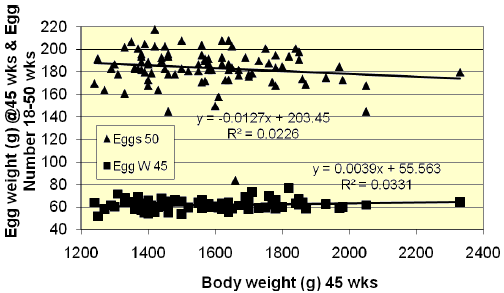
Commercial WL Performance
A similar examination of the commercial WL strain performance indicates that approximately 10 per cent of the birds also achieved egg production performances greater than 90 per cent between 18 to 50 weeks of age (Figure 4.). For the commercial WL the correlation between body weight at 45 weeks of age and egg weight at 45 weeks was stronger than for the bantam cross ( R2=0.112 versus 0.0331)(Figures 3 and 4).
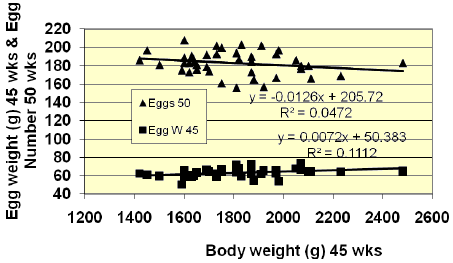
Elite Bantam Cross Performance
A selection of the best 30 per cent of the bantam cross birds (Elite bantam cross exceeded 190 eggs in 224 days, and averaged 88.9 per cent production ) were maintained from 18 to 72 weeks of age (Figure 5.). An aggregation of the production performance of these birds illustrated a peak production of 98 per cent at 24 weeks of age and hen day production levels averaging 308 eggs to 72 weeks of age. Average body weight and egg weight of these selected birds (Elite bantam cross) was no different from the flock average (Bantam Cross) of 1575 and 61.6g, despite the superior egg production performance. Egg production to 72 weeks of age was negatively correlated with body weight (-0.0526) (Figure 5), and suggests higher egg production in the small birds.
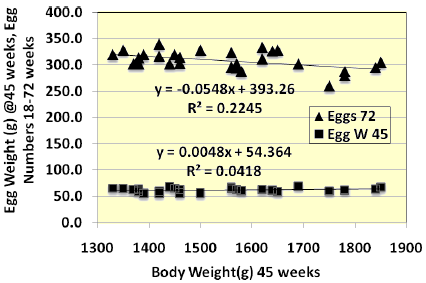
It is anticipated that the production performance and egg mass output can be further improved by crossing the bantam line with a superior female parent line, further selection of the pure bantam line, and/or a selection program that identifies the populations of pure bantams and commercials that produce progeny with a superior genetic recombination of small bantam body size but high egg mass outputs. As anticipated, the ratio of egg weight to body weight in the bantam cross was considerably higher than in the commercial WL birds and illustrates the potential of bantam genes to influence this ratio. A few individual bantam cross birds had egg weight to body weight ratios as high as 5 per cent.
Introgression of Bantam Genes
Additional research has recently been undertaken to introgress bantam genes into the commercial WL (results not presented in this paper). This process has involved selection of superior first cross (F1) bantams and mating these females to small first cross (F1) males. In the next generation (F2), approximately 30 per cent of the population was again selected for small body size and high egg mass output. These selected F2 females had a mature body weight of approximately 1500g, but high egg production characteristics. In a subsequent F3 generation, a bantamised bird has been produced that has a mature body weight of 1400g with egg production characteristics similar to the original commercial WL.
Two lines of normal sized commercial WL’s (1800-1900g) (Line L and Line C) have been bantamised in this fashion, and have been called the L50 and C75. Both lines have a mature body weight of approximately 1400 g with commercial egg production characteristics. The cross breeding of these two lines(L50 and C75) has produced a hybrid with a body size of 1430g, an average egg size of 60-61g and a rate of production of 87 per cent between 20-50 weeks of age. This hybrid would be commercially competitive, and is likely to exhibit 5 per cent higher feed efficiency than the smallest commercial White Leghorn currently available in the world.
The global trend towards out-of-shell egg products will also increase the emphasis on feed conversion efficiency at the expense of shell colour and probably very large eggs, and lends strong support to the development of the sorts of commercial lines described. Additional research will be directed at evaluating both bantam cross WL’s with superior egg production performance and bantam crosses generated from brown egg layers.
References
Parkinson, G.B. and Cransberg, P.H. 2000. Proceedings, Australian Poultry Science Symposium, 12:129-132.
Stanhope, W. and Parkinson, G.B. 1989. Proceeding Worlds Poultry Science Congress Nagoya, Japan. p432-433
Yoshida, S. and Saito, K. 1983. Proceedings, The Fifth World Conference on Animal Production, 2:115-116.
Further Reading
| - | You can view other papers in the proceedings by clicking here. |
March 2011








